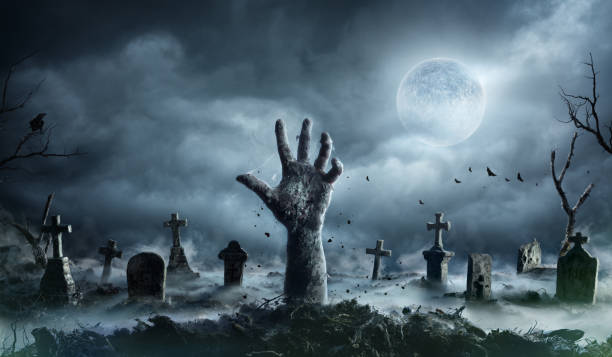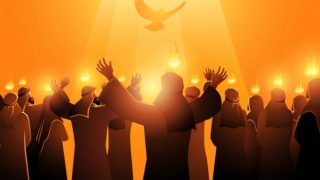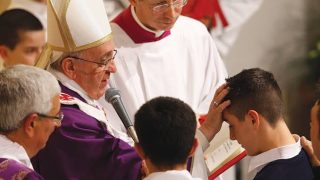
CHRIST THE GIVER OF LIFE
HOMILY FOR FIFTH SUNDAY OF LENT, YEAR A. Readings: Ezekiel37:12-14; Psalm 130; Romans 8:8-11 and John 11:1-45.
In the liturgy of today, we recall the creation story of the lifelessness of man and the breath of life that was given to man. On the first Sunday of this season, Christ was led by the Spirit and in his public ministry, he worked with the Holy Spirit. On the cross he will give up the Spirit and on Easter day this same Spirit will resurrect him from the dead and will restore life to the mortal bodies of all who believe in him.
In the first reading, the Lord said through the Prophet Ezekiel, “Behold, I will open your graves. And raise you from your graves; and I will bring you home into the land of Israel” (Ez. 37:12). Yahweh, in this reading, tells us his purpose of restoring life to the dead or dry bones, referring to the whole house of Israel. That is, both northern and southern (Judah) Israel. Ezekiel was to tell the people that Yahweh intends to open their graves and bring them back to their homeland from exile. Yahweh first showed a pile of dry bones lying on the valley floor. Now he presents us with the image of closed graves being opened. While these two images are different, they both served same purpose. Both points to Yahweh’s redeeming and apparently hopeless situation for his people, a situation as hopeless as dry bones or as hopeless as closed graves. The exilic experience of Israel and Judah made them have no hope of escape in the hands of their captors, no hope of seeing their homeland and no hope of being restored as a nation.
It suffices to note that though we might be living in our country yet, we could still say our experiences are not different from the Israelites in exile as sin has separated us from God. Our situation seems to be hopeless and our nation being in a closed grave. We had hope of a better nation but it seems we lost it, our bones have become dry and some have been cut off by tribal bigots. Of recent, the pronouncement of election results has made so many places look like graveyard. In the midst of these, God is saying to us as he did say to the Israelite, “I will open your grave and raise you from the dead… and I will put my Spirit within you, and you shall live, and I will place you in your own land…” (vv. 13-14). If Yahweh breathes into Israel the breath of life, Israel will come alive once more. Invariably, without the Spirit of God, we are dead. We may be physically alive but spiritually dead. It is only the Spirit of God that can deliver us from this hopelessness. It is commonly said, “When there is life, there is hope.” However, God is saying “I am the giver of life to the lifeless body.” A redemptive work of the unimaginable and a promise of restoration so wide and deep. Nothing is too late for God to redeem.
St. Paul in the second readings tells us, “Those who are in the flesh cannot please God. But you are not in the flesh, you are in the Spirit, if the Spirit of God really dwells in you… But if Christ is in you, although your bodies are dead because of sin, your spirits are alive because of righteousness” (Rom 8:8-10). The Holy Spirit is given to each of us at baptism. It is this Spirit that will enable us participate in the resurrection.
In the gospel, Christ speaks of himself as the resurrection and the life through the resurrection of Lazarus. He could not have achieved this without the power of the Holy Spirit. John 1-12 includes a series of seven signs, which are: changing water to wine (2:1-11); healing of the royal official’s son (4:46-54); the healing of a paralytic (5:1-9); feeding of the five thousand (6:1-14); giving sight to a man born blind (9:1-12) and the periscope of today, the resurrection of Lazarus from the dead, which reveals Christ as the resurrection and life. This is the only sign that took place in Bethany, the village of Mary and Martha. Lk 10:38-42 describes Jesus visit to the home of Mary and Martha, and will return again in Jn 12:1-8, when Mary will anoint him with expensive perfume and wipe his feet with her hair.
Hence, there are lots of parallel and contrast between the resurrection of Lazarus and Jesus, as the anointing mention in verse 2 foretell the anointing for Jesus’ burial. Both Lazarus and Jesus are buried in the tomb sealed by stone, which is moved so that the resurrection person can emerge. Jesus asked, “Where have you laid him?” (11:34), the same question that Mary will ask the gardener at Jesus’ tomb (Jn 20:15). Both accounts mention grave cloths. However, there is a significant contrast here. Lazarus emerges from his tomb bound in his grave cloths (v. 44). Peter and the other disciple will find an empty tomb with linen wrappings lying there, and the cloth that had been on Jesus’ head rolled up in a place by itself (20:5-7), a testimony that Jesus will not require this grave cloth again.
When Jesus got the news of Lazarus’ illness, he stayed two days before going to Bethany of Judea (v.6) and he said, “This illness is unto death; it is for the glory of God, so that the Son of God may be glorified by means of it” (v.4). the delay serves to heightened that glorification by removing any possibility that that Lazarus is merely in a coma. When he finally arrived in Bethany, Lazarus will have been dead four days. Invariably, no ambiguity about his death, the sign or God’s involvement. The fact that Lazarus has been in the tomb four days means that there can be no possibility of his soul rejoining his body as it was in the Jewish belief in the case of three days. Four days is shorthand for “hopeless.”
As in the case of Mary, when Martha heard of the arrival of Jesus, she said, “Lord, if you had been here, my brother would not have died” (vv.21.32). Interestingly is the faith of Mary and Martha. Martha expresses faith that God will give Jesus whatever he asks, but in v. 39 she will protest against the removal of the stone because of the stench of death. Like most of us, she believes and fail to believe. Jesus told her that her brother will rise again. Martha responded yes, he will at resurrection, but for now, the reality at the time is that Lazarus is dead. This moment becomes the heart of the gospel periscope as Jesus said to her, “I am (ego eimi) the resurrection and the life” (v.25). While we call this story the resurrection of Lazarus, it is more importantly the revelation that Jesus is the resurrection and the life. “I AM,” is God’s name revealed to Moses in the burning bush (Ex 3:14). Disclosing his identity to Martha, he asks her, “Do you believe?” She replied with a threefold statement of faith that Jesus is the Messiah, the Son of God and the one coming into the world.
Finally, the sign of the resurrection of Lazarus serves the purpose of the glory of God (v.4); authenticate Jesus as the resurrection and the life (v.25) and confirm the promise that “He who believes in me, will never die” (vv.25-26). May Christ speak to our closed grave and bring all that pertains us to life. Amen!
Happy Sunday!
Fr. Ken Dogbo, OSJ










